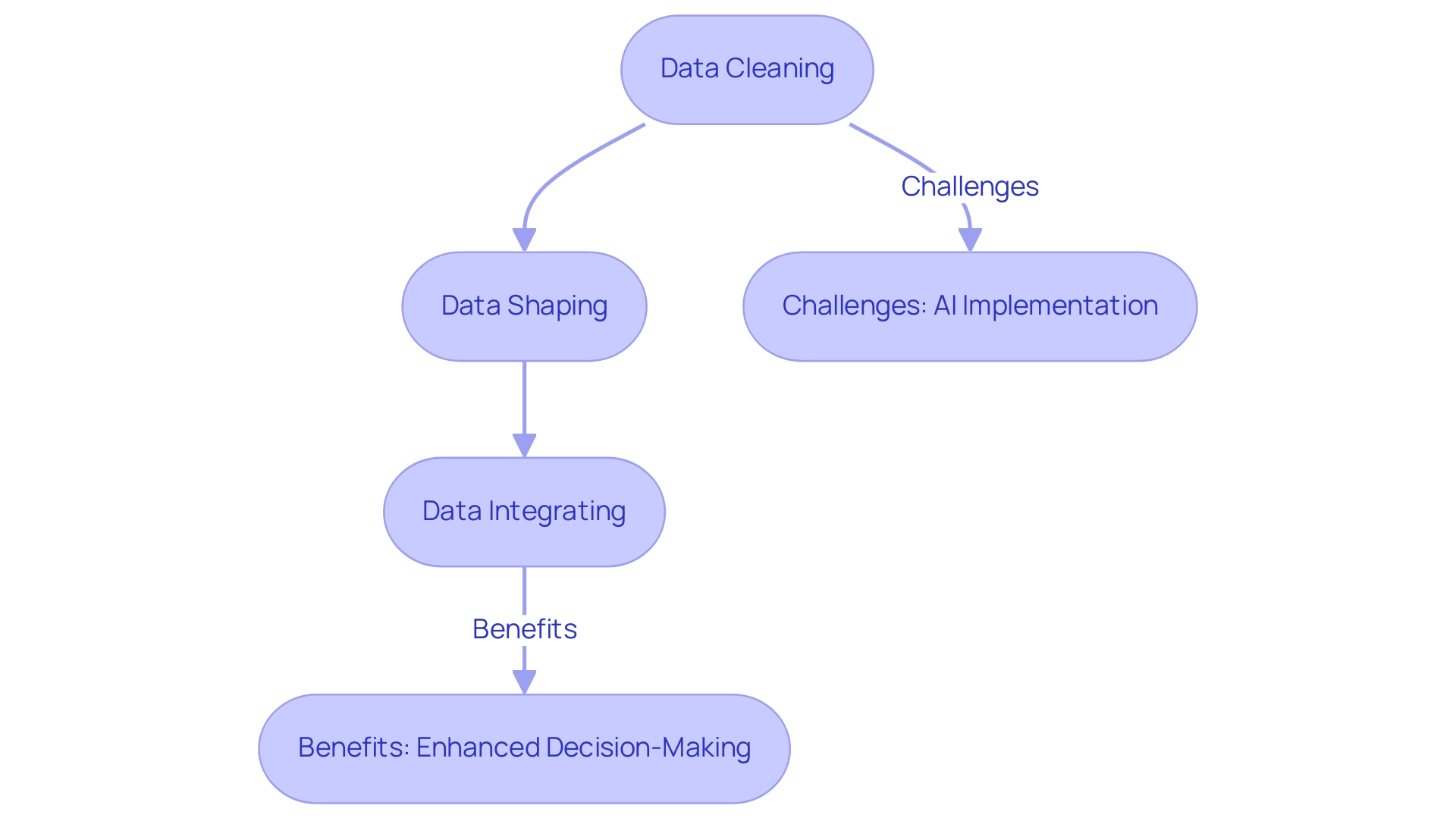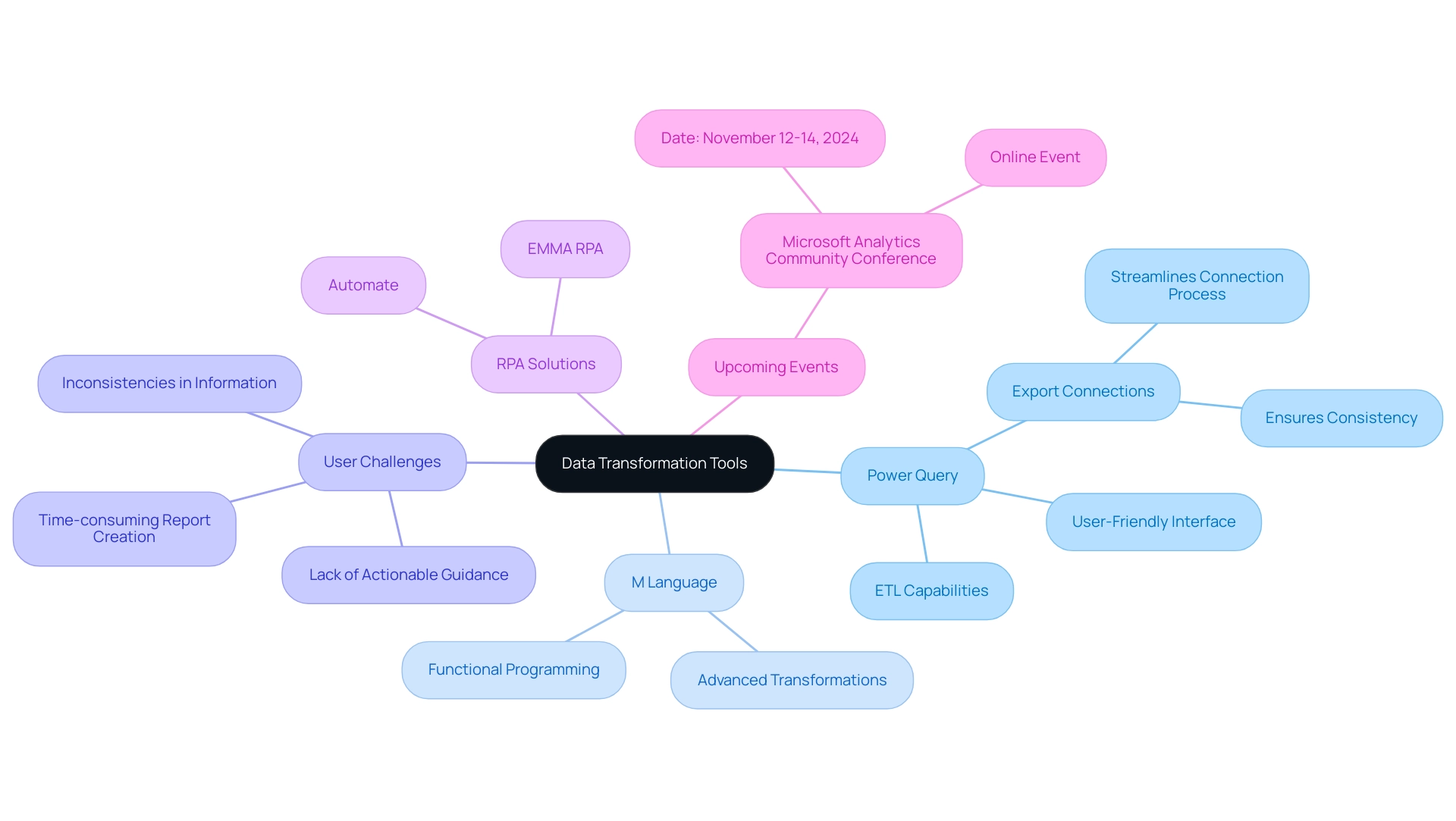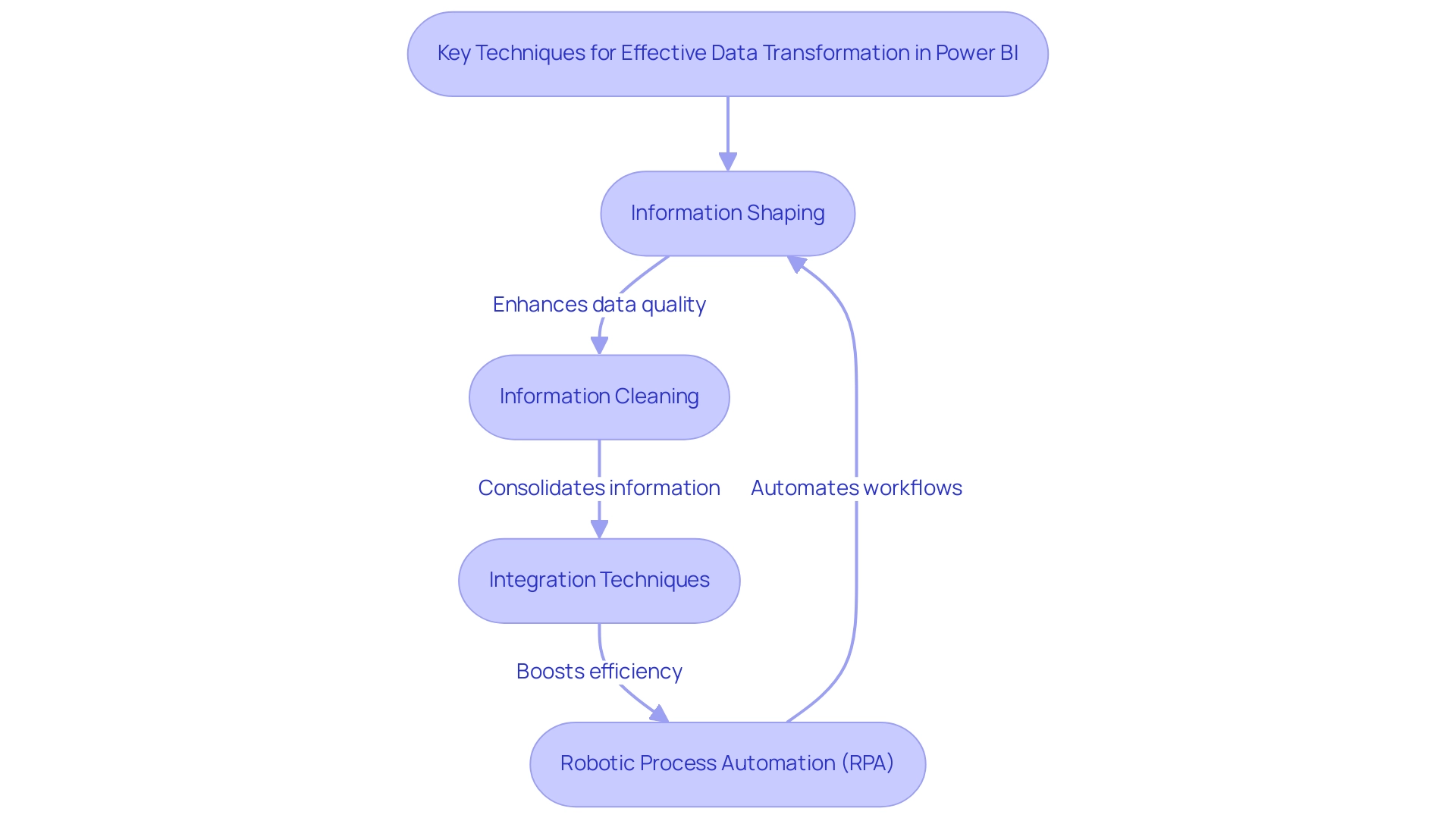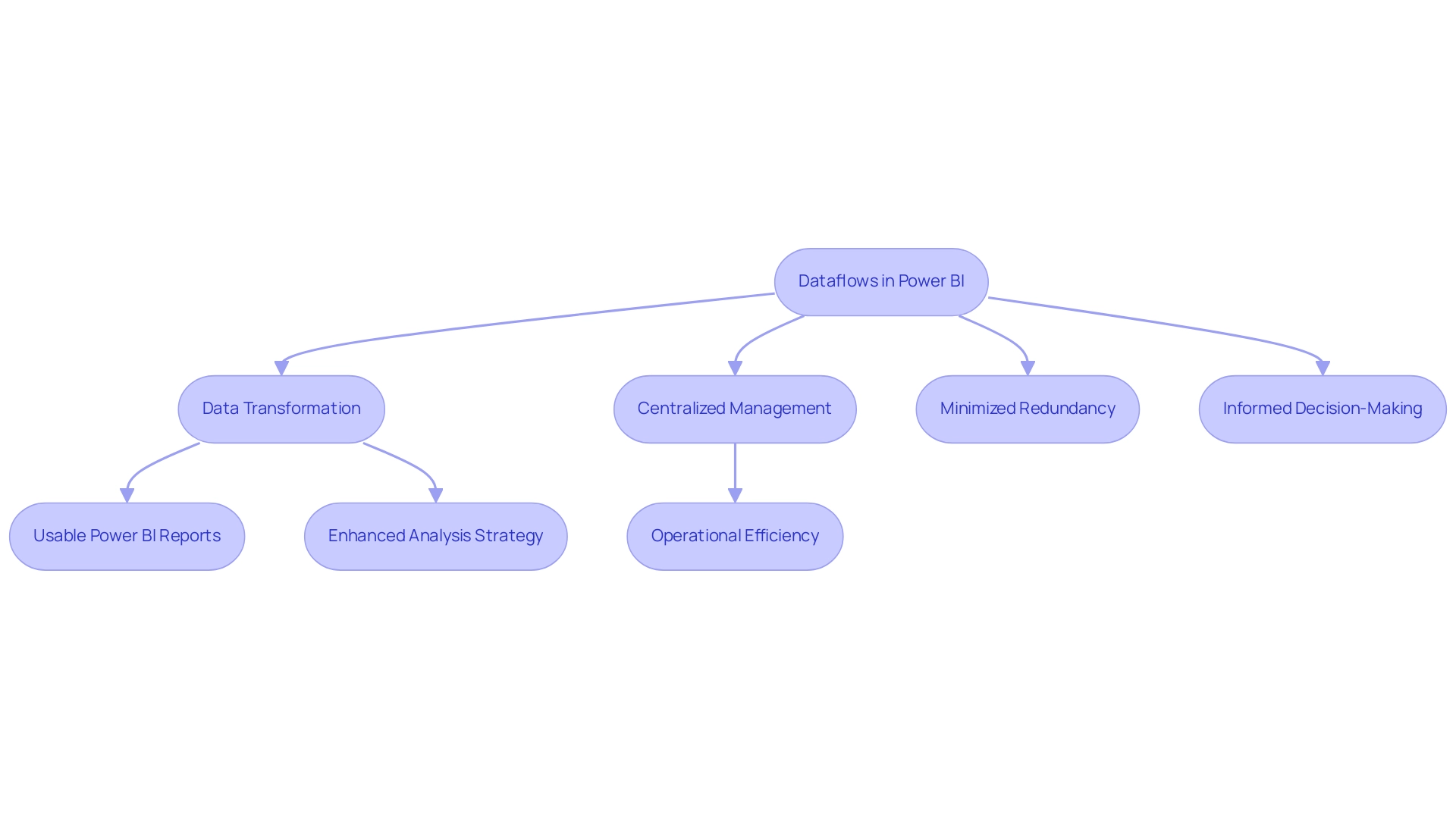Introduction
In the age of information, the ability to transform raw data into actionable insights is paramount for organizations striving to thrive in a competitive landscape. Data transformation in Power BI emerges as a pivotal process, enabling businesses to clean, shape, and integrate diverse data sources with precision.
As companies grapple with challenges such as economic uncertainty and the complexities of digital transformation, understanding the nuances of data management becomes essential for operational success. By leveraging advanced tools like Power Query and M Language, along with innovative strategies such as Robotic Process Automation (RPA), organizations can streamline workflows, enhance data quality, and empower teams to focus on strategic initiatives.
This article delves into the critical techniques and best practices for effective data transformation, illuminating the path toward maximizing analytics capabilities and driving informed decision-making in an ever-evolving digital landscape.
Understanding Data Transformation in Power BI
The process of data transformation in Power BI is essential, involving the conversion of raw information into a structured format suitable for analysis and reporting. This intricate process includes:
- Cleaning
- Shaping
- Integrating information from diverse sources
Ensuring both accuracy and consistency. As organizations traverse a progressively intricate digital environment, understanding data transformation in Power BI is essential for enhancing analytics abilities.
Moreover, addressing prevalent views regarding AI, especially the difficulties of implementation, such as inadequate master information quality and organizational reluctance to adopt AI, is crucial for operational success. A recent report indicates that 22% of IT leaders view economic uncertainty as a significant challenge to implementing digital changes, underscoring the need for reliable data practices amidst fluctuating market conditions.
Effective data transformation in Power BI not only enhances data quality but also empowers businesses to make informed decisions swiftly, improving their ability to adapt to market dynamics. Incorporating Robotic Process Automation (RPA) can further streamline workflows, reduce manual errors, and free up teams for more strategic tasks, ultimately driving data-driven insights and operational efficiency. While some may view AI projects as time-consuming and expensive, companies can alleviate these concerns by adopting structured approaches and utilizing tools that simplify integration.
Companies employing advanced technologies, like those provided by WalkMe’s Digital Adoption Platform, significantly enhance the chances of successful changes. Evidence suggests that organizations adapting digital tools to meet employee needs more than double the chances of achieving desired outcomes, leading to higher employee satisfaction and profitability. Furthermore, since digital changes can generate and remove jobs, it requires the advancement of new digital abilities, demonstrating the wider effects of data transformation in Power BI on today’s evolving workforce.

Exploring Tools for Data Transformation: Power Query and M Language
Power Query stands out as a formidable tool within BI, empowering users to seamlessly connect, combine, and refine content from diverse sources. Its user-friendly interface simplifies information transformation tasks, allowing users to execute operations such as filtering, sorting, and merging datasets effortlessly—no extensive coding knowledge required. As emphasized by Sayantoni Das,
Query is a commonly utilized ETL (Extract, Transform, Load) tool,
underscoring its essential role in the analytics landscape.
However, many users still encounter challenges with BI dashboards, such as:
- Time-consuming report creation
- Inconsistencies in information
- A lack of actionable guidance
In this context, incorporating RPA solutions such as EMMA RPA and Automate can significantly improve operational efficiency by automating repetitive tasks and lessening the load on staff, thus enabling users to concentrate on extracting actionable insights from their information. In contrast, M Language acts as a functional programming language that specifies the complexities of information alteration processes within Query.
It caters to advanced users by offering enhanced flexibility and control, enabling them to implement complex transformations that exceed the capabilities of the graphical interface. Significantly, choosing three columns can yield median or sum statistics, illustrating Query’s practical uses in analysis. Moreover, the upcoming Microsoft Analytics Community Conference, scheduled for November 12-14, 2024, presents an excellent opportunity for users to engage with the community and learn more about these tools.
Furthermore, the case study titled ‘Export Connections’ demonstrates how Query allows users to export connection details, streamlining the process of establishing connections and ensuring consistency in analysis projects. Together, Power Query and M Language establish a strong framework for effective data transformation in Power BI, equipping users with the essential tools to enhance their analysis projects while overcoming the typical challenges encountered in maximizing BI capabilities.

Key Techniques for Effective Data Transformation
Effective data transformation in Power BI is crucial for organizations aiming to leverage analytics for informed decision-making, especially in a rapidly evolving AI landscape. This process of data transformation in Power BI includes several key techniques, such as shaping, cleaning, and integration, which are significantly enhanced through Robotic Process Automation (RPA). Information shaping organizes and structures information to meet specific analytical requirements, ensuring that it is presented in a manner conducive to insight generation.
RPA can automate these manual workflows, boosting efficiency and reducing errors, thereby freeing your team for more strategic, value-adding work. Meanwhile, information cleaning focuses on identifying and rectifying errors or inconsistencies within the dataset, which is essential for maintaining integrity. However, many entities face significant challenges in implementing RPA and BI, including resistance to change and the complexity of integrating new technologies with existing systems.
According to recent studies, companies that adjust their technologies to meet employee needs can achieve up to 23% higher employee satisfaction and 22% greater profitability, emphasizing the significance of precise information in fostering a positive work environment. Yet, it’s important to note that in 2021, only 35% of companies worldwide achieved their digital objectives, illustrating the significant challenges organizations face. Furthermore, resistant company culture is noted as a challenge by 14% of respondents, suggesting that overcoming internal obstacles is crucial for successful information change.
Integration techniques further enhance the data transformation in Power BI by allowing users to consolidate information from various sources, creating a comprehensive view that is invaluable for analysis. For instance, the BFSI segment leads the digital transformation market with the largest revenue share, driven by enhanced consumer experiences and advanced technology adoption, which serves as a successful example of how effective information management can drive growth. With 17% of IT projects failing to a degree that threatens company survival, as noted in a study by the University of Oxford and McKinsey, the implications of effective information management cannot be overstated.
By utilizing these transformative techniques alongside RPA, entities not only ensure that their information is accurate and pertinent but also establish the foundation for obtaining meaningful insights through data transformation in Power BI, which can drive strategic decision-making and enhance operational efficiency. Furthermore, tailoring AI solutions to meet specific business needs is essential, as it allows organizations to address unique challenges and leverage technology effectively.

Leveraging Dataflows for Enhanced Data Management
Dataflows in Power BI are crucial for data transformation in Power BI, optimizing information conversion processes at scale and significantly enhancing efficiency across various reports and dashboards. By allowing users to define, manage, and centralize transformation tasks, dataflows minimize redundancy and ensure that all stakeholders access the same up-to-date information—vital for informed decision-making regarding data transformation in Power BI. As Sascha Rudloff, Team leader of IT and Process Management at PALFINGER, observed, ‘The outcomes of the sprint surpassed our expectations and were a significant enhancement for our analysis strategy.’
The recent success of CREATUM’s Power BI Sprint with PALFINGER demonstrates the impact of data transformation in Power BI: it not only led to an immediately usable Power BI report and gateway setup but also expedited PALFINGER’s overall Power BI development, enhancing their analysis strategy. Furthermore, information flows can connect to a variety of sources, establishing a consistent pipeline that enhances quality and accessibility across departments through data transformation in Power BI. As of 2024, the usage of information flows has surged, underscoring their growing importance in the effective management of data transformation in Power BI.
Recent advancements, such as saving information flows as drafts, support data transformation in Power BI, providing entities with enhanced flexibility in managing their strategies and driving operational efficiency. Additionally, leveraging refresh statistics optimizes performance, while case studies such as ‘Mitigating Long Refresh Durations’ provide practical solutions for addressing challenges associated with data transformation in Power BI and complex dataflows. The incorporation of Robotic Process Automation (RPA) further improves this process by automating repetitive tasks, which not only alleviates the burden of time-consuming report creation but also addresses inconsistencies, empowering operations leaders to harness insights that drive business growth and efficiency.

Best Practices for Transforming Data in Power BI
To enhance data transformation in Power BI, organizations must adopt a set of best practices that streamline processes and improve collaboration while leveraging Robotic Process Automation (RPA) to automate manual workflows.
Firstly, maintaining clear documentation of all change steps is crucial; it fosters knowledge sharing and ensures that team members can easily understand and replicate processes. Moreover, applying a filter condition to showcase rows where Total Amount is greater than or equal to $100 acts as a practical illustration of practices that prioritize information quality.
Secondly, prioritizing information quality through systematic validation checks and thorough cleaning routines is essential within the data transformation in Power BI workflow, as it directly impacts the reliability of analytics outcomes. Moreover, harnessing the power of Power Query and M Language allows teams to automate repetitive tasks, minimizing human error and enabling analysts to concentrate on strategic initiatives, thus enhancing operational efficiency and freeing up resources for more value-adding work. Merging queries to combine information based on a common column is another key practice that enhances integration and analysis.
As entities navigate the rapidly evolving AI landscape, routinely assessing and refreshing transformation practices to address shifting business needs and information sources is essential. This landscape presents challenges that tailored AI solutions can help address, ensuring entities can cut through the noise and implement effective strategies. As emphasized by the quote from Power BI, ‘Learn about the Power BI security best practices to protect your valuable information,’ implementing these strategies ensures high-quality information for reporting and maximizes the value of investments in advanced analytics.
By following these best practices and integrating RPA, organizations can significantly enhance their data transformation in Power BI capabilities, ultimately leading to improved business outcomes.

Conclusion
The journey of effective data transformation in Power BI is pivotal for organizations aiming to thrive in a competitive landscape. Through the processes of cleaning, shaping, and integrating diverse data sources, businesses can enhance data quality and make informed decisions swiftly. The integration of advanced tools like Power Query and M Language, alongside Robotic Process Automation (RPA), empowers teams to streamline workflows, reduce manual errors, and focus on strategic initiatives that drive growth.
Implementing key techniques such as:
- Data shaping
- Cleaning
- Integration
not only enhances operational efficiency but also lays the groundwork for deriving meaningful insights. As organizations embrace dataflows, they can centralize and manage transformation tasks, ensuring that all stakeholders have access to the most accurate and up-to-date information. This capability is essential for informed decision-making in today’s rapidly evolving digital landscape.
By adopting best practices that prioritize documentation, data quality, and systematic validation, organizations can significantly improve their data transformation processes. This enables them to navigate the challenges posed by economic uncertainty and digital transformation with confidence. Ultimately, effective data management and transformation strategies are not just about technology; they are about empowering teams to harness the full potential of their data, driving operational efficiency and fostering a culture of data-driven decision-making. Embracing these practices today will pave the way for a more resilient and successful future.
